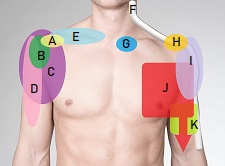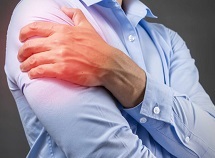- Home
- Shoulder Muscles
Muscles Of The Shoulder
Written By: Chloe Wilson BSc (Hons) Physiotherapy
Reviewed By: SPE Medical Review Board
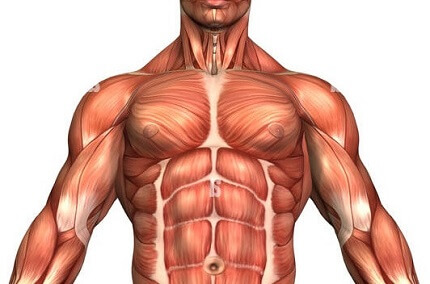
The muscles of the shoulder work together to control the strength, stability and function of the shoulder girdle.
The shoulder joint sacrifices bony stability for incredible mobility, allowing the shoulder to move through the most extensive range of motion of the whole body.
The muscles of the shoulder play a vital role in providing stability and control to protect the joint. They also let the arm move through a huge range of motion in many directions, and control functional activities such as lifting, carrying, pushing, pulling and throwing.
Shoulder muscle injuries are common, particularly in people who do a lot of over-head activities e.g. swimming, racket sports and pitching and as we get older.
Here we will look at the structure of the shoulder, shoulder muscle anatomy, how the different muscles work and what can go wrong.
The Structure Of The Shoulder
The shoulder girdle is actually made up of four different shoulder joints:
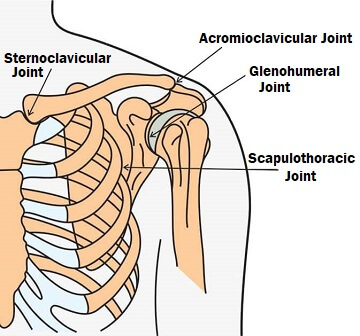
- Glenohumeral Joint: Joint between the head of the humerus and the glenoid fossa (the “ball” shape on top of the upper arm bone and shallow "socket" formed on the shoulder blade)
- Scapulothoracic Joint: Joint between the shoulder blade and rib cage
- Acromioclavicular Joint: Joint between the acromion (part of the shoulder blade) and the clavicle (collar bone)
- Sternoclavicular Joint: Joint between the clavicle (collar bone) and sternum (breastbone)
Each of the shoulder joints are formed and supported through a network of bone structures, muscles, ligaments, tendons, bursa, cartilage and a joint capsule.
Find Out More: The Structure Of The Shoulder
Shoulder Muscle Functions
The muscles of the shoulder have a numbers of different functions including:
- Shoulder & Arm Movement: The shoulder muscles move the upper arm and shoulder girdle through flexion, extension, abduction, adduction, internal and external rotation, elevation and depression, protraction and retraction
- Connecting The Upper Limb To The Trunk: To transmit forces from the hands and arm to the central body
- Stabilising the Shoulder: The rotator cuff muscles of the shoulder help to deepen the shoulder socket and draw the head of humerus into the socket for increased stability
- Stabilising The Scapula: The posterior shoulder muscles control and allow smooth movement of the shoulder blade which helps protect the shoulder
- Preventing Joint Dislocation: The muscles of the shoulder play a huge role in preventing the joints moving out of place
- Tightening The Joint Capsule: Some of the muscle feed in to the joint capsule which helps to improve joint stability and reduces friction
The Muscles Of The Shoulder
Let’s have a look at the different muscles of the shoulder, where they are located, how they work and what can go wrong. We have grouped them into three sets of shoulder muscle anatomy according to their function.
1. Rotator Cuff Muscles
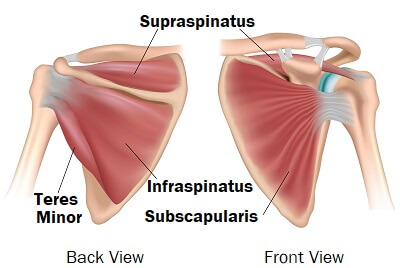
The rotator cuff muscles of the shoulder surround the glenohumeral joint like a cuff, hence the name, and are the primary stabilising muscles of the shoulder.
They run between different parts of the scapula
and head of humerus and are responsible for a large range of motion in
multiple directions.
- Supraspinatus: The smallest rotator cuff muscle. Supraspinatus runs over the top of the shoulder, underneath the acromion and initiates abduction, helping to lift the arm out to the side.
- Infraspinatus: A thick, triangular muscle at the back of the shoulder that runs from the bottom of the scapula to the humeral head. Infraspinatus is the main external rotator if the shoulder, twisting the arm outwards
- Teres Minor: A narrow muscle that runs around the back of the shoulder from the outer portion of the scapula to the front of the upper arm, just below the head of humerus. Teres minor twists the arm outwards (external rotation) and draws it in towards the body (adduction)
- Subscapularis: A large, triangular shaped muscle that runs from the inner border of the scapula to the front of the upper arm, just below the head of humerus. Subscapularis twists the arm inwards (internal rotation). It also provides important stability for the shoulder during overhead activities e.g. throwing
All four rotator cuff muscles of the shoulder play a vital role in the stability and mobility of the shoulder. The positioning of the rotator cuff muscles also draws the head of humerus into the glenoid fossa, improving congruity and stability. Without the rotator cuff, the downward gravitational forces and weight of the arm would pull the head of humerus out of the glenoid fossa, effectively pulling the ball out of the socket.
Common Problems: The rotator cuff shoulder muscles are frequently injured through repetitive wear and tear, overloading or overstretching. Rotator cuff tears and tendonitis are common problems affecting these shoulder muscles, often due to impingement syndrome.
2. Shoulder Blade Muscles
There are a number of shoulder muscles that provide movement and stability at the shoulder blade.
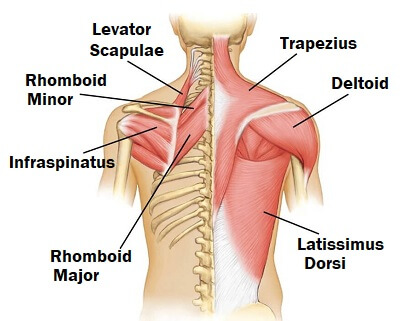
As the upper arm moves, the shoulder blade needs to move smoothly and freely in multiple directions - protraction, retraction, elevation, depression, upward and downward rotation.
The shoulder blade muscles provide vital stability to allow full movement at the shoulder without the risk of injury.
The main muscles of the shoulder blade are:
- Trapezius: The trapezius muscle of the shoulder is the large triangular muscle that runs superficially from the base of the skull, more than half way down the spine and fans out to attach to the clavicle and scapula. The main function of trapezius are to control shoulder blade stability and support posture.
- Rhomboids: There are two rhomboid muscles of the shoulder, rhomboid major and rhomboid minor that sit between the inner border of the scapula and the upper back, just underneath the trapezius muscles. Their main actions are to draw the shoulder blade back, fixing and stabilising the shoulder blade, and help maintain posture.
- Serratus Anterior: is a key stabilising muscle of the scapula responsible for drawing the shoulder blade flat against the ribcage. The serratus anterior muscle runs between the upper ribs and the front of the scapula bone controlling scapular protraction and upward rotation.
- Levator Scapulae: A small strap-like shoulder muscle that lifts the shoulder blade up
Common Problems: The most common problems with the shoulder blade muscles are weakness and tightness. These can be addressed with scapula strengthening exercises and trapezius stretches.
3. Other Muscles Of The Shoulder
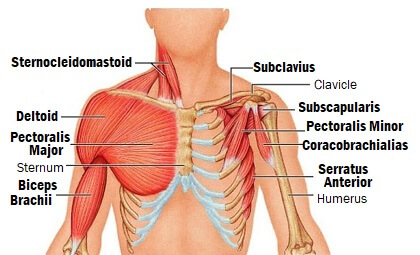
There are a number of other shoulder muscles that work alongside the rotator cuff and shoulder blade muscles to help to move and control the shoulder joint.
They are arranged in different layers and completely encircle the shoulder joint for maximum stability.
- Deltoid: A thick, triangular shaped muscle, the deltoid muscle sits over the top of the shoulder joint to give it its characteristically rounded contour shape. There are three distinct parts to this shoulder muscle due to its broad point of origin along the clavicle and scapula. The different parts are responsible for different arm movements including abduction, flexion and extension. Deltoid is the most superficial shoulder muscle, sitting on top of the rotator cuff muscles and works with them to retract, rotate and stabilise the shoulder.
- Pectoralis Muscles: The large, superficial pec major muscle is found on the front of the chest and supports and moves the anterior shoulder into flexion, adduction, extension and medial rotation. The smaller pectoralis minor muscle is much smaller, and sits underneath pec major, drawing the shoulder forwards and downwards
- Latissimus Dorsi: One of the larger back muscles that sits between the lower part of the spine and the upper arm. Lat dorsi extends, adducts and medially rotates the upper arm and keeps the lower portion of the scapula in position against the chest wall
- Teres Major: runs from the bottom tip of the scapular up to the front of the humerus bone. Teres major works with the latissimus dorsi muscle in the acceleration and follow through phases of throwing actions as well as extending, adducting and internally rotating the shoulder.
- Biceps: The biceps are found on the front of the upper arm running between the shoulder blade and the elbow. The primary function of the biceps muscle is to flex and rotate the forearm outwards (supination) but it also helps to flex the shoulder
- Triceps: The triceps are found on the back of the upper arm running between the scapula and upper humerus to the elbow. The main function of the triceps is to straighten the elbow but it also helps to adduct and extend the shoulder. One of the triceps tendons also attaches to the shoulder joint capsule and helps to hold the humeral head in the socket at the glenoid fossa, improving stability.
- Subclavius: A small, triangular shaped muscle that runs between the collar bone and the first rib. Subclavius stabilises the collar bone while the shoulder and arm move
- Coracobrachialis: Runs alongside pec minor and the short head of biceps from midway down the back of the humerus to the coracoid process at the front of the scapula. Helps to flex the shoulder and adduct and internally rotate the arm. Coracobrachialis also helps to stabilise the head of humerus, especially when the arm is hanging down by you side.
Shoulder Muscle Actions
Here’s a simple list of the different movements that occur at the shoulder and which muscles of the shoulder produce and control those movements:
- Shoulder Flexion: Deltoid, pec major, coracobrachialis, biceps
- Shoulder Extension: latissimus dorsi, pec major, teres major, deltoid, triceps
- Internal Rotation: subscapularis, teres major, deltoid, latissimus dorsi, pec major, coracobrachialis
- External Rotation: teres minor, infraspinatus, deltoid
- Abduction: supraspinatus, deltoid
- Adduction: Teres major, teres minor, coracobrachialis, pec major, latissimus dorsi, triceps
- Scapula Movement & Stability: trapezius, rhomboids, serratus anterior, levator scapulae
Common Shoulder Muscle Problems
Injuries to the muscles of the shoulder are common, particularly as we age. Muscle and tendon damage may be caused by:
- Overuse: which leads to inflammation
- Overstretching: where the muscle is stretched beyond its elastic limit and tears
- Wear & Tear: gradual wear and tear over time usually due to friction caused by poor shoulder stability
Common shoulder muscle problems include:
- Tendonitis: inflammation of one of the shoulder tendons e.g. supraspinatus tendonitis, biceps tendonitis, triceps tendonitis
- Impingement Syndrome: Shoulder impingement syndrome causes wear and tear of the shoulder muscles & tendons
- Muscle Tear: Overstretching, overloading or repetitive friction leads to tearing e.g. rotator cuff tear
- Bursitis: Inflammation of the sacs that sit between muscle tendons and bone e.g. shoulder bursitis, scapulothoracic bursitis, subacromial bursitis
Exercises For Shoulder Muscles
Having good strength in the muscles of the shoulder is really important to reduce the risk of shoulder injuries and ensure full range, control and function of the arm.
If you are looking to improve the strength, stability and/or flexibility of your shoulder muscles, check out the following rehab exercises:
- Rotator Cuff Exercises: a combination of mobility, stretching and strengthening exercises for the rotator cuff muscles. Perfect for beginners
- Rotator Cuff Strengthening: Improve the strength of the rotator cuff muscles using resistance bands. Perfect mid-level exercises
- Scapular Stabilization Exercises: Improve the strength, stability and control of the shoulder blade muscles. A must for anyone with shoulder pain
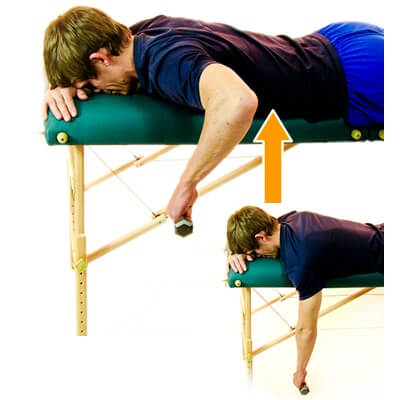
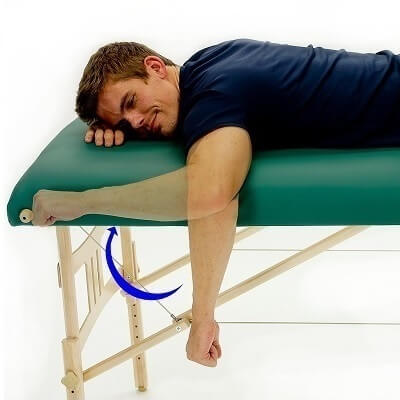
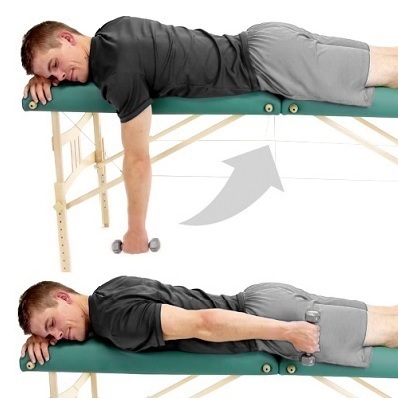
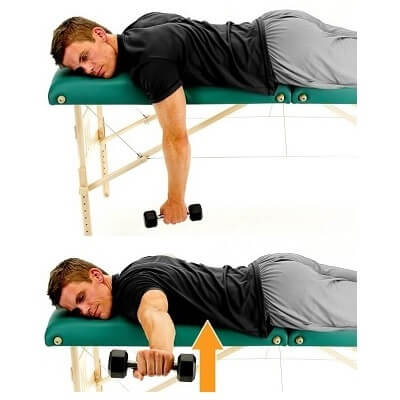
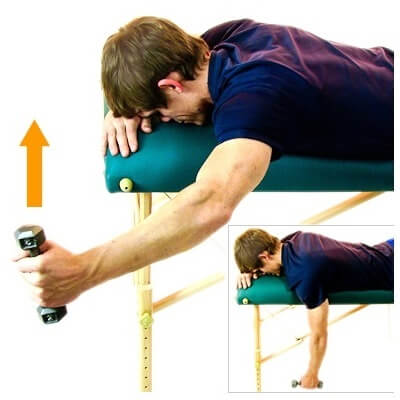
It is also important to have good flexibility in the shoulder muscles so that the arm can move freely. If you are looking to improve the strength, stability and/or flexibility of your shoulder muscles, check out the following articles:
- Shoulder Mobility Exercises: improve the range of motion at your shoulder. Perfect in the early stages after an injury or surgery
- Shoulder Stretches: for the rotator cuff and upper arm muscles to improve shoulder range. Perfect if you are looking to stretch your shoulder
- Trapezius Stretches: Tight traps is a really common problem that causes shoulder, neck and upper back pain. Trapezius stretches are perfect for people who spend long periods at a computer
- Upper Back Stretches: Upper back stiffness often restricts shoulder movements. Particularly helpful for people with flexed or slumped posture
If you are not sure where to start, I would suggest starting with a combination of rotator cuff exercises and scapula stability exercises.
And if you have any pain in or around your shoulder, it is really important to find out what is causing your pain before exercising the muscles of the shoulder – check out the shoulder pain diagnosis section for help working out what might be wrong and how best to treat it.
If you want to know more about the different structures in and around the muscles of the shoulder, visit the shoulder anatomy section.
Related Articles
Medical & Scientific References
- National Library Of Medicine: Anatomy, Shoulder and Upper Limb, Shoulder Muscles
- Human Kinetics Journal: Effect of Stretching and Strengthening Shoulder Muscles on Forward Shoulder Posture in Competitive Swimmers
- AAFP: Chronic Shoulder Pain: Part I. Evaluation and Diagnosis
- Brazilian Journal Of Physical Therapy: Scapular and rotator cuff muscle activity during arm elevation: a review of normal function and alterations with shoulder impingement
- AOJ Journal: Clinical anatomy and stabilizers of the glenohumeral joint
Page Last Updated: November 5th, 2024
Next Review Due: November 5th, 2026

